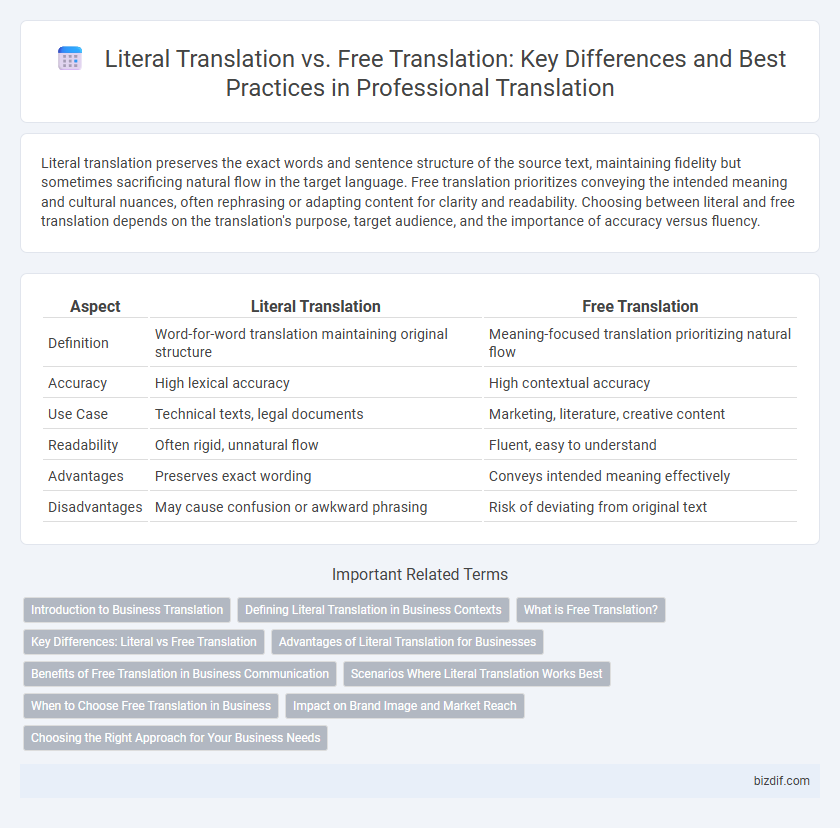Literal translation preserves the exact words and sentence structure of the source text, maintaining fidelity but sometimes sacrificing natural flow in the target language. Free translation prioritizes conveying the intended meaning and cultural nuances, often rephrasing or adapting content for clarity and readability. Choosing between literal and free translation depends on the translation's purpose, target audience, and the importance of accuracy versus fluency.
Table of Comparison
| Aspect | Literal Translation | Free Translation |
|---|---|---|
| Definition | Word-for-word translation maintaining original structure | Meaning-focused translation prioritizing natural flow |
| Accuracy | High lexical accuracy | High contextual accuracy |
| Use Case | Technical texts, legal documents | Marketing, literature, creative content |
| Readability | Often rigid, unnatural flow | Fluent, easy to understand |
| Advantages | Preserves exact wording | Conveys intended meaning effectively |
| Disadvantages | May cause confusion or awkward phrasing | Risk of deviating from original text |
Introduction to Business Translation
Literal translation in business translation emphasizes word-for-word accuracy, ensuring the source text's structure and terminology are preserved for legal or technical documents. Free translation prioritizes conveying the intended meaning and cultural context, making it ideal for marketing materials and international communication where clarity and persuasion are essential. Choosing the appropriate approach depends on the document's purpose, target audience, and the need for either precision or adaptability.
Defining Literal Translation in Business Contexts
Literal translation in business contexts involves converting text word-for-word from the source language to the target language, maintaining the original structure and terminology. This approach ensures consistency in technical documents, contracts, and financial reports where precise language and specific jargon are critical for legal and operational accuracy. However, it may sacrifice natural flow and cultural relevance, making it less effective for marketing materials or customer communications.
What is Free Translation?
Free translation prioritizes conveying the overall meaning and context of the original text rather than adhering strictly to word-for-word equivalence. This approach allows translators to adapt idioms, cultural references, and nuances to better resonate with the target audience. By focusing on fluency and readability, free translation enhances comprehension while maintaining the original message's intent.
Key Differences: Literal vs Free Translation
Literal translation preserves the exact wording and structure of the source text, ensuring high accuracy but often sacrificing naturalness and readability in the target language. Free translation prioritizes conveying the intended meaning and cultural nuances, allowing for more flexibility and adaptation to the target audience's context. Key differences include fidelity to source text, fluency in target language, and the balance between word-for-word accuracy versus conceptual equivalence.
Advantages of Literal Translation for Businesses
Literal translation ensures accuracy and consistency in conveying specific terminology, which is crucial for maintaining brand integrity and legal compliance in business documents. It enables businesses to preserve the original message's precise meaning, minimizing the risk of misinterpretation in contracts, product descriptions, and technical manuals. This approach supports clear communication across multilingual markets, enhancing trust and professionalism.
Benefits of Free Translation in Business Communication
Free translation enhances business communication by prioritizing meaning over word-for-word accuracy, ensuring messages resonate with the target audience's cultural context. This approach improves clarity and prevents misunderstandings, fostering stronger relationships with international clients and partners. Adopting free translation in marketing materials and contracts increases engagement and drives global business success.
Scenarios Where Literal Translation Works Best
Literal translation excels in technical documents, legal texts, and scientific papers where precise terminology and exact meanings are crucial. It ensures consistency and accuracy by maintaining original phrasing and structure, which is essential for user manuals and patent documentation. This approach minimizes ambiguity and preserves the source content's integrity in specialized fields requiring strict adherence to terminology.
When to Choose Free Translation in Business
Free translation is ideal in business when conveying marketing messages, cultural nuances, or adapting content for target audiences to ensure clarity and engagement. It prioritizes meaning and intent over exact word-for-word accuracy, making it suitable for promotional materials, branding, and international communications. Choosing free translation helps businesses resonate better with local markets, enhancing communication effectiveness and brand perception.
Impact on Brand Image and Market Reach
Literal translation preserves the exact wording of the original content, maintaining brand consistency but risking cultural misinterpretations that can alienate target audiences. Free translation adapts the message to local idioms and cultural nuances, enhancing emotional connection and broadening market reach while potentially diluting the original brand tone. Balancing literal accuracy with cultural relevance is crucial for strengthening brand image and expanding global market presence.
Choosing the Right Approach for Your Business Needs
Literal translation preserves the exact wording and structure of the source text, ensuring accuracy for legal or technical documents where precision is critical. Free translation adapts the message to fit cultural nuances and target audience preferences, making it ideal for marketing materials and creative content. Selecting between these approaches depends on your business goals, target market, and the type of content being translated to maximize effectiveness and engagement.
Literal Translation vs Free Translation Infographic

 bizdif.com
bizdif.com